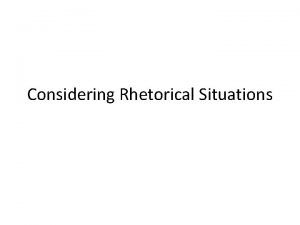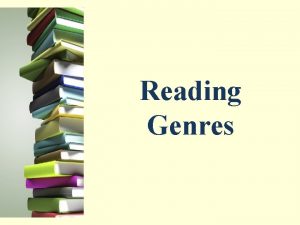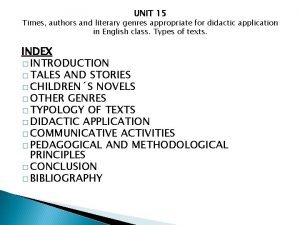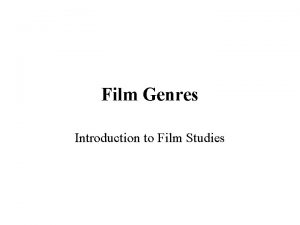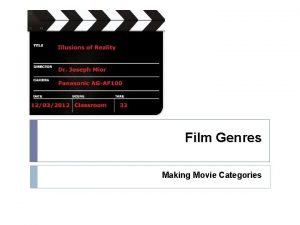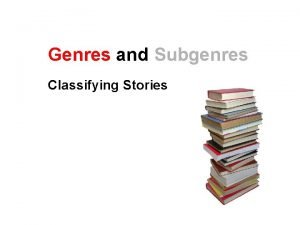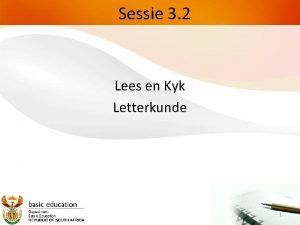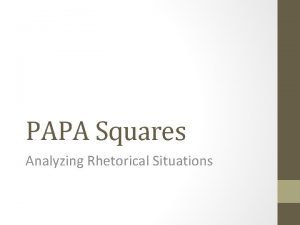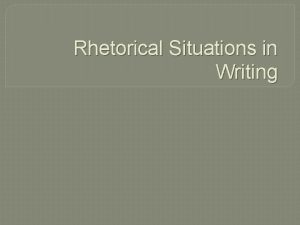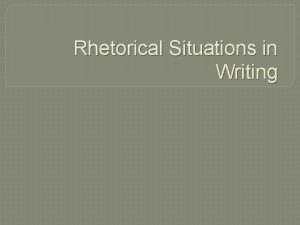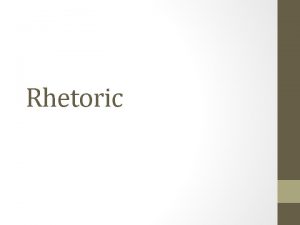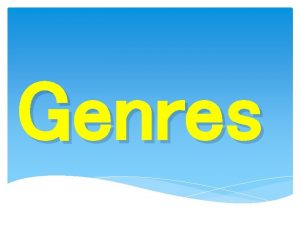Review of Genres Rhetorical Situations and Reading Rhetorically








- Slides: 8

Review of Genres, Rhetorical Situations, and Reading Rhetorically For Freshman English B (second half of first-year writing) Corresponds to Chapters 1 -2 of How Writing Works and Chapters 2 -3 of Everyone’s An Author

What does “genre” mean? • In general, “genre” means “type, ” “category, ” or “group” – “Essay” is just one genre of writing, though people often use it more liberally • Texts within the same genre will have similar features or elements; these “conventions” are what is expected of the genre • Identifying the genre of a text you are reading will help you understand its purpose • Identifying what genre a writing assignment calls for will help you understand what’s expected of you

What genres exist? • Too many to list, but here are some examples: – – Essays Reviews Proposals Reports • And often, genres have sub-genres, e. g. : – Narratives = literacy narratives, memoirs, personal statements, etc. – Analyses = literary analyses, rhetorical analyses, causal analyses, etc. – Arguments = position papers, refutations, visual arguments, etc. • And, sometimes, genres are combined, e. g. : – Narrative argument – Argumentative Report

Topic How to identify the genre: Purpose Audience • If trying to identify the genre of a text you’re reading or what genre you should write in for an assignment, ask: – What? (Topic) – What is the text? What is being communicated? What can you tell about it from reading (or what does the writing assignment say)? – Who? (Audience) – Who is the intended audience? Who else might read the text? Different audiences will expect different things from a text. – Why? (Purpose) – What is the text for? What is its purpose? What is it’s goal? Why was it written (or why are you writing it)? What is the author (or you) trying to accomplish? • You might remember these as the “big three” from critical reading: topic, audience and purpose

What does “rhetorical situation” mean? • In general, “rhetorical situation” is the “context” for a document/text. • It’s the term used to describe the circumstances that give rise to a text (or the need for a text), including: – Purpose (Why? ) – Author’s role (Who is the author? Credentials? Biases? Relationship to audience? ) – Audience’s needs (What does audience expect? Friendly/Neutral/Hostile? Relationship to topic or author? ) – Timing of text (Is it appropriate? Relevant? ) • This should remind you of the rhetorical triangle …

Rhetorical Triangle

Rhetorical Situation • Genre • Audience • Purpose • Stance • Larger Context • Medium and Design This should sound familiar – it’s very similar to what we should be considering when “reading like a writer”

“Reading Like a Writer” Or “reading rhetorically” or “critical reading” or “annotating” • Preview text, considering topic, author/sponsor, publisher, audience • Then, read carefully, considering and annotating on the following: – – – – Author (who it is, stance, style/tone) Purpose (why) Audience (values) Design (every detail is a decision, what is effect) Claim, reasons and evidence Counterarguments (strengths and weaknesses) Larger context • AND respond in writing by summarizing the main ideas and discussing your reactions to text
